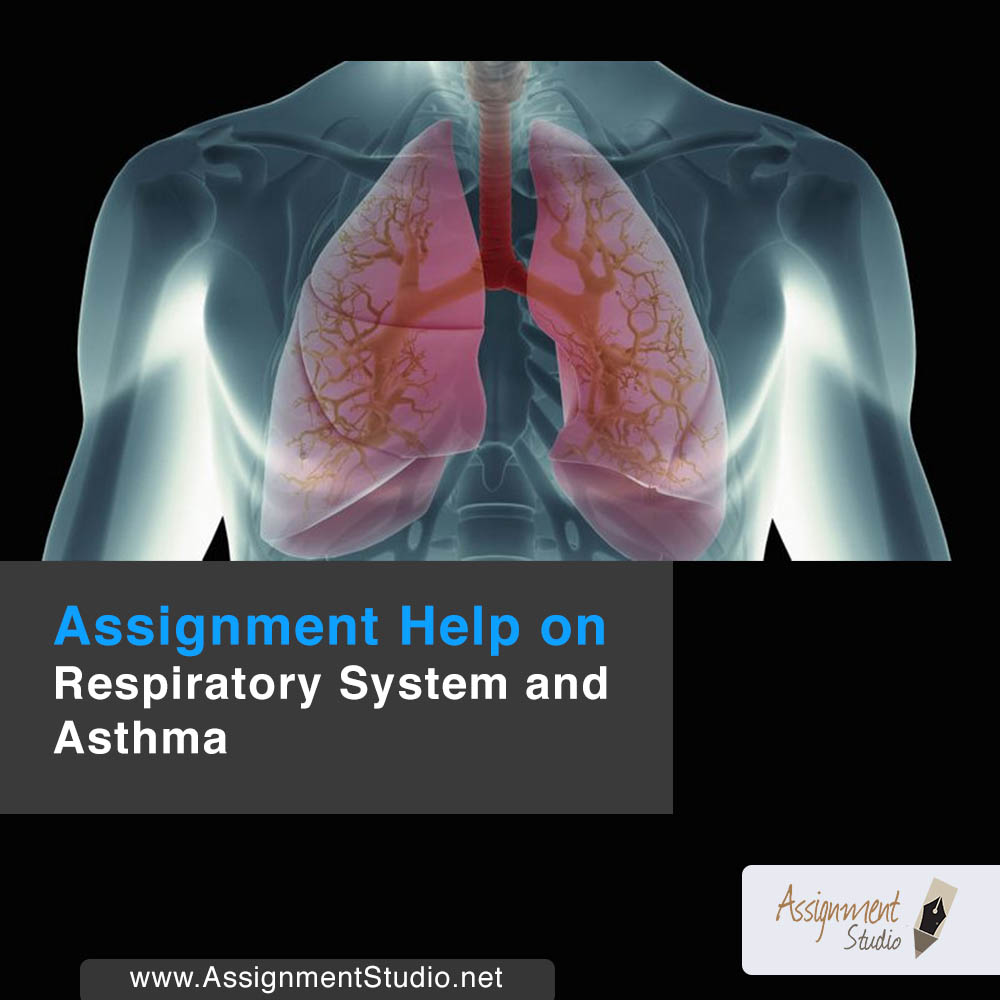Assignment Help on Respiratory System and Asthma
Respiratory system is a highly coordinated system of vital organs like lungs (enclosed in ribcage) that is supplied by system of blood vessels and respiratory muscles like diaphragm to ensure the delivery of oxygenated blood to all parts of the body via pumping action of heart (Gulshan Sharma and James Goodwin, 2006). The human respiratory system acts as a purification system to deliver oxygen for aerobic processes to all the cells of the body and in turn extract and excrete carbon dioxide and other metabolic gases and toxins produced as a result of biological processes. The respiratory system extend from nostrils that serves as a conduit for the passage of atmospheric air to lungs via vertical tube- trachea that divides into 2 bronchus, each leading to right and left lung. For optimal breathing, normal functioning of respiratory system is of utmost importance. However, with aging, exposure to certain toxins, physical or biochemical insults and other congenital or acquired diseases, the physiological process of breathing can be significantly affected that increases the risk of hypoxia and altered metabolism.
Asthma is categorized under chronic obstructive pulmonary diseases and constitutes a multitude of symptoms like reversible limitation of airflow across respiratory apparatus, hyperresponsiveness of airways to local and systemic stimuli and episodic/ periodic difficulty in breathing (CG Irvin and Wenzil, 1996).
The primary pathophysiologic event that leads to airway changes is inflammatory reactions that produce symptoms like cough, increased mucus production, wheezing, chest tightness or feeling of excessive pressure in the chest cavity, difficulty in breathing marked by shortness of breath and changes in the arterial blood gases (ABGs). Researchers believe that problematic asthma is the failure of body’s hyperimmune system to shut down inflammatory processes (CG Irvin and Wenzil, 1996).
ABOUT ASTHMA
Asthma significantly affects the quality of life and research survey indicates that the overall cost of treating asthma is equivalent to individual costs of congenital defects, ambulance services, home care, perinatal illnesses, hematological disorders, congenital and infectious disorders (Krahn, Berka, Langlois & Detsky, 1996). This high cost is attributed to direct cost of treatment, emergency medical services, in-patient care, research and education, drugs and devices and physician billing as well as indirect cost from loss of productivity due to inability to perform professional and domestic responsibilities and pre- mature death if emergent and urgent medical care is not available in case of severe attack (Krahn, Berka, Langlois & Detsky, 1996)
Epidemiological data suggest that almost 50% patients fall under the range of 15-34 years old. Statistical data suggest that different treatment protocols are practiced in different parts of the world and even in same countries but different centers according to the condition and disease status of patient and preference of physicians. According to Australian Bureau of Statistics, almost 10% of entire Australian population suffer from chronic asthma requiring medical therapy. Data also suggest that most asthmatic flares reported in Australian adult population are due to prescription of inadequate drug dosage while adult Australian patients are mostly the ones receiving the high potency combinations of inhaled corticosteroid and long-acting beta2-agonist instead of low dose inhaled corticosteroid. People with asthma should be reassessed once or twice a year to re-adjust the treatment plan if necessary. If patients shows worsening of symptoms, other medical conditions should be considered like rhinitis, cardiac failure or vocal cord dysfunction. The proper use of inhalers is fundamental in asthma control. Health care practitioners should always make sure the patient knows how to use his devices properly. Identification and avoidance of obnoxious stimuli that may induce an attack like cigarette smoke, cold air, drugs, irritants and air pollutants is also an essential part of prevention of asthma flare (Easton & Hillman, 1981)
Drug treatment for asthmatic patients accordingly to the National Asthma Council Australia:
The drugs to treat asthma are classified as: relievers, preventers, symptom controllers and combination medication.
The above assignment is not complete, if you are looking for complete assignment, similar assignment or a new one you can contact us by filling up the quote form
How We Can Help:
We provide high quality University Assignment Help at reasonable price because we understand your financial constraints. You can avail Best Assignment help Service without spending too much money. Our clients always come back to us with more Academic Help because we earn their trust by providing the Best Professional Assignment Help in Australia. Our Case Study Help is not limited for Australian students but international students can also avail it.




